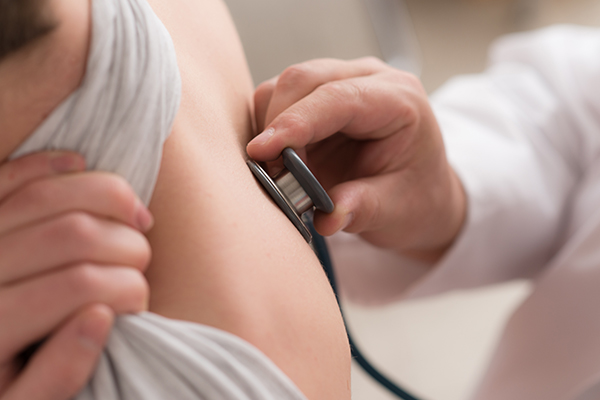Respirology
Looking for a Pulmonary Function Test (PFT)? At the WELL Health Clinic Network, we provide quick and convenient access to the care you need. Our dedicated healthcare providers are committed to delivering exceptional care, assisting you every step of the way.

Respirology Near You
Your Respirology Questions Answered
What is a pulmonary function test?
Pulmonary function tests (PFTs) are non-invasive tests that show how well the lungs are working. The tests measure lung volume, capacity, rates of flow, and gas exchange. This information can help your healthcare provider diagnose and decide the treatment of certain lung disorders.
It’s important to note, a referral is needed from your family doctor, a nurse practitioner, or another physician.
How does a pulmonary function test help diagnose and manage respiratory conditions?
Pulmonary function tests (PFTs) assess lung function before surgery or other medical procedures and treatments. They are used in patients with lung or heart problems, smokers, and individuals with other health conditions
Additionally, PFTs play a vital role in evaluating the effectiveness of treatments for conditions such as asthma, emphysema, and other chronic lung problems. Your healthcare provider may recommend PFTs for various other reasons as well.
There are two types of disorders that cause problems with air moving in and out of the lungs:
- Obstructive: This is when air has trouble flowing out of the lungs due to airway resistance. This causes a decreased flow of air.
- Restrictive: This is when the lung tissue and/or chest muscles cannot expand enough. This creates problems with air flow, mostly due to lower lung volumes.
Pulmonary function tests can be done with two different methods. These methods may be used together and perform different tests, depending on the information that your healthcare provider is looking for:
- Spirometry: A spirometer is a device with a mouthpiece hooked up to a small electronic machine.
- Plethysmography: You sit or stand inside an air-tight box that looks like a short, square telephone booth to do the tests.
A pulmonary function test (PFT) measure:
- Tidal volume (VT): This is the amount of air inhaled or exhaled during normal breathing.
- Minute volume (MV): This is the total amount of air exhaled per minute.
- Vital capacity (VC): This is the total volume of air that can be exhaled after inhaling as much as you can.
- Functional residual capacity (FRC): This is the amount of air left in the lungs after exhaling normally.
- Residual volume: This is the amount of air left in the lungs after exhaling as much as you can.
- Total lung capacity: This is the total volume of the lungs when filled with as much air as possible.
- Forced vital capacity (FVC): This is the amount of air exhaled forcefully and quickly after inhaling as much as you can.
- Forced expiratory volume (FEV): This is the amount of air expired during the first, second, and third seconds of the FVC test.
- Forced expiratory flow (FEF): This is the average rate of flow during the middle half of the FVC test.
- Peak expiratory flow rate (PEFR): This is the fastest rate that you can force air out of your lungs.
Normal values for PFTs vary from person to person. Your test results compare the amount of air inhaled and exhaled to the average for someone of the same age, height, sex, and race. They also compare your results to any previous test results. If you have abnormal PFT measurements or if your results have changed, your healthcare provider may recommend other tests.
Pulmonary function tests (PFTs) serve various purposes, including routine check-ups for healthy individuals and regular assessments in specific work environments to ensure employee health (e.g., graphite factories and coal mines). Additionally, your healthcare provider may conduct PFTs to help diagnose health problems such as:
- Allergies
- Respiratory infections
- Trouble breathing from injury to the chest or a recent surgery
- Chronic lung conditions, such as asthma, bronchiectasis, emphysema, or chronic bronchitis
- Asbestosis is a lung disease caused by inhaling asbestos fibres
- Restrictive airway problems from scoliosis, tumours, inflammation or scarring of the lungs
- Sarcoidosis is a disease that causes lumps of inflammatory cells around organs, such as the liver, lungs, and spleen
- Scleroderma is a disease that causes thickening and hardening of connective tissue
Are there any specific preparations or precautions I should take before undergoing a pulmonary function test?
Your healthcare provider will explain the procedure and answer your questions about PFTs before the test. You may need to sign a consent form that gives permission. Read the form carefully. Ask questions if anything is not clear.
Tell your healthcare provider if you take any medicines, including prescriptions, over-the-counter medicines, vitamins, and herbal supplements.
Make sure to:
- Stop taking certain medicines before the procedure if instructed by your healthcare provider.
- Stop smoking before the test if instructed by your healthcare provider. Ask your provider how many hours before the test you should stop smoking.
- Not eat a heavy meal before the test if instructed by your healthcare provider.
- Follow any other instructions your healthcare provider gives you.
To help calculate your results, your weight and height will be taken before the test.
What can I expect during and after a pulmonary function test?
During your PFT
In most cases, the procedure will follow this process:
- The technologist will ask you to loosen tight clothing, jewelry, or other things that may cause a problem with the PFT.
- If you wear dentures, you must wear them during the procedure.
- You’ll need to empty your bladder before the procedure.
- You’ll sit in a chair. A soft clip is placed on your nose, ensuring you breathe through your mouth.
- You will insert a sterile mouthpiece attached to a spirometer.
- You’ll form a tight seal over the mouthpiece with your mouth and receive instructions on inhaling and exhaling in different ways.
- Throughout the test, the healthcare provider will monitor you for dizziness, trouble breathing, or other problems.
- You may be given a bronchodilator after some PFTs. You will repeat the test several minutes after the bronchodilator has taken effect.
After your PFT
If you have a history of lung or breathing problems, you may feel tired after the tests. Your healthcare provider will talk with you about your test results.
For Ontario patients, visit myhealthcentre.ca for more information about what to expect at your pulmonary function test.
How do I find a pulmonary function test near me?
You can use the WELL Clinics website to quickly find a respirology clinic near you. If you have a requisition, select the button below to book a pulmonary function test.
If you don’t have a referral or requisition but would like to request a pulmonary function test, book with your family doctor or use our clinic map to find a primary care clinic or telehealth service and book an appointment.





